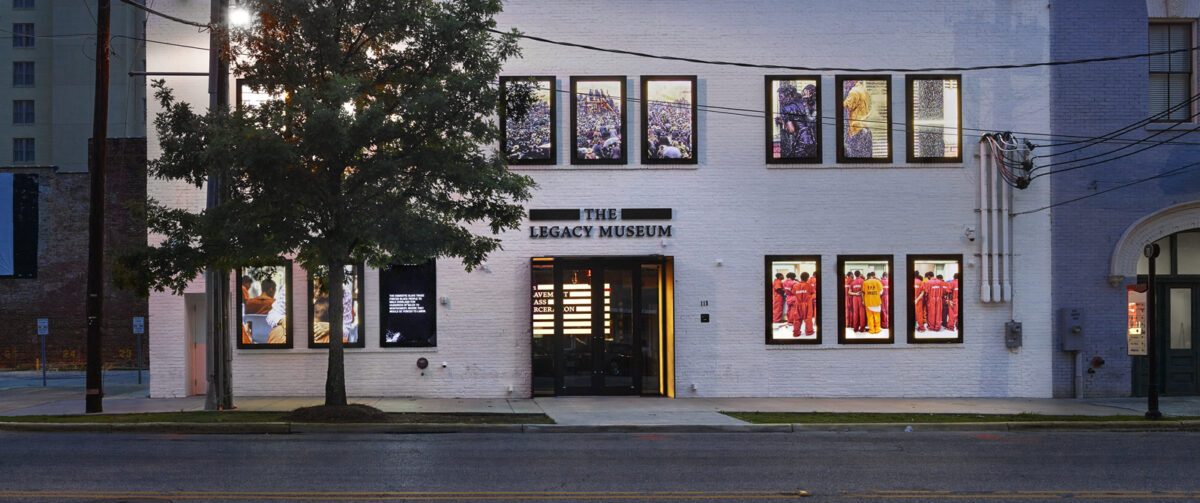by Bryan & Heather
A couple years back, a unique commemorative effort was making waves in the historical community. Brian Stevensson, civil rights lawyer and founder of the Equal Justice Initiative, had purchased land in Montgomery, Alabama to construct a museum documenting the history of lynching in the United States and an accompanying memorial to that history’s thousands of victims. We remember our intrigue at this provocative public history proposal when we first heard of it, but as we were living in California, a museum in central Alabama wasn’t exactly in the cards. With our recent move to Birmingham, however, our interest was rekindled, and as part of our Independence Day 2021 festivities, we decided to drive down to Montgomery and reflect on some of our nation’s less proud traditions.
The Legacy Museum, as it is called, is not quite a museum in the traditional sense. With one exception (more on that below), it holds no artifacts of any kind, instead interpreting its history through interactive exhibits and recreating historical documents and photographs. Indeed, in some ways the museum seems more like the historical version of a local science center or athletics exhibition. It begins its coverage with the banning of the trans-Atlantic Slave Trade and opening of the domestic slave trade in 1808. Though it at least briefly touches on the highlights of the black experience in America in the subsequent two hundred and thirteen years, it rests its primary focus on four particular themes: the aforementioned domestic slave trade (for which Montgomery was a notable hub), lynching, segregation and the Montgomery bus boycott, and modern mass incarceration.
The history on display is comprehensive and, at times, slightly overwhelming (which isn’t helped by the museum’s unintuitive layout). Due to how underserved these subjects usually are, we felt an obligation to interact as much as possible with the exhibits before us, but entire walls covered in quotes bearing witness to slaves’ suffering, segregationist legislature, statements from segregationist politicians, or letters from modern prisoners can make even the stoutest historian’s heart quail. It does make for powerful statements however, and for us none more powerful than the single collection of artifacts the Legacy Museum displays. In the center of its main room is a shelf that bears a collection of jars, each one filled with soil collected from the sites of recorded lynchings and bearing the location, date, and victim’s name (if known). It is powerful testimony to the scale of extrajudicial murder that has taken place in the United States (Bryan counted a single instance that executed nine men whose names have been lost), and that history is further expanded upon nearby with an interactive database relating the details of these incidents and more.

As with any good public history, the Legacy Museum attempts to leave its visitors rethinking their relationships with the history it interprets. It’s shrine honoring civil rights activists silently (and admirably) includes a number of controversial figures including Nat Turner, John Brown, and Sitting Bull. It then explicitly poses a number of questions to its visitors which, while somewhat pedestrian to us, do try to get people to think about the racial assumptions underpinning our society. There was even a kernel of new knowledge for us about our new home state: even though Federal law and the Supreme Court have prohibited segregation for over fifty years, Alabama voters actively chose to keep language in the state constitution mandating white and black children attend different schools in 2004 and again in 2012. The language was only removed last year in 2020. Talk about a long way to go.
While these final leading questions are admirable, we couldn’t help feeling like the Legacy Museum had played it surprisingly safe, given its originally provocative premise. We would have loved to see so many more opportunities seized: dates of repeal on segregationist laws, showing how late they lasted, if indeed they’re even officially off the books; statements from modern politicians next to those from half a century ago, demonstrating how much racist rhetoric has both changed and remained the same; even some physical artifacts to drive home the horrors of slavery as it was lived. In short, I had hoped for something that actively challenges the public’s comfortable view of their country (like the Whitney Plantation we visited outside of New Orleans), not just “Do you think America should still be racist?” Ultimately, however, this amounts to a fairly academic critique of an otherwise outstanding institution.
We are only beginning to scratch the surface of the history Alabama has to offer, but even at this early date, it’s safe to say that the Legacy Museum will likely make any final list of must see attractions in this state so defined by slavery and its legacy. While we ended up not having time to visit the accompanying memorial (an offsite location a few miles away, accessed by a shuttle), that only gives us a reason to come back in the near future.
